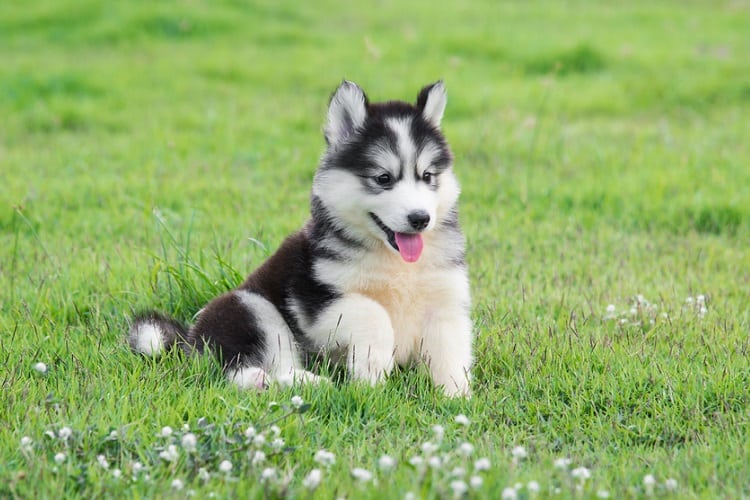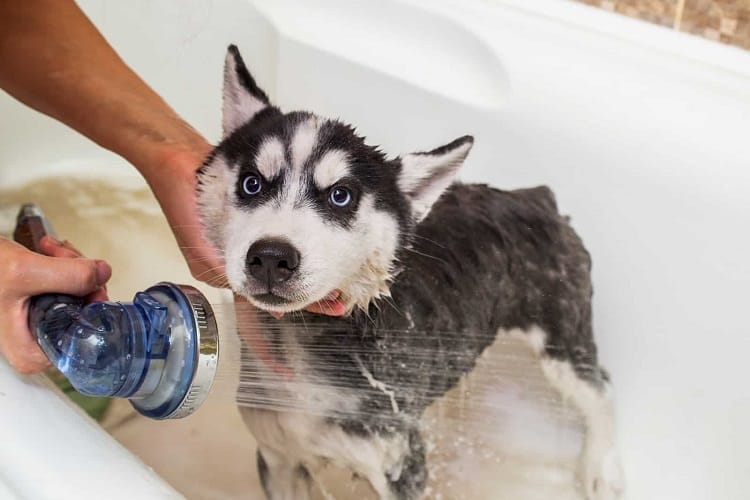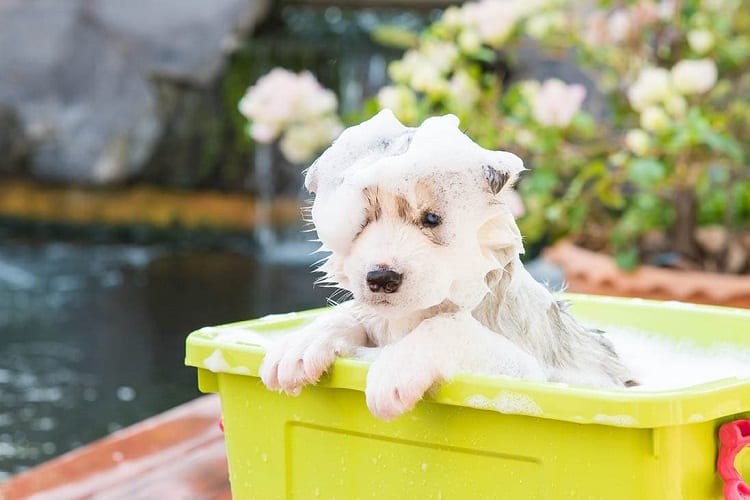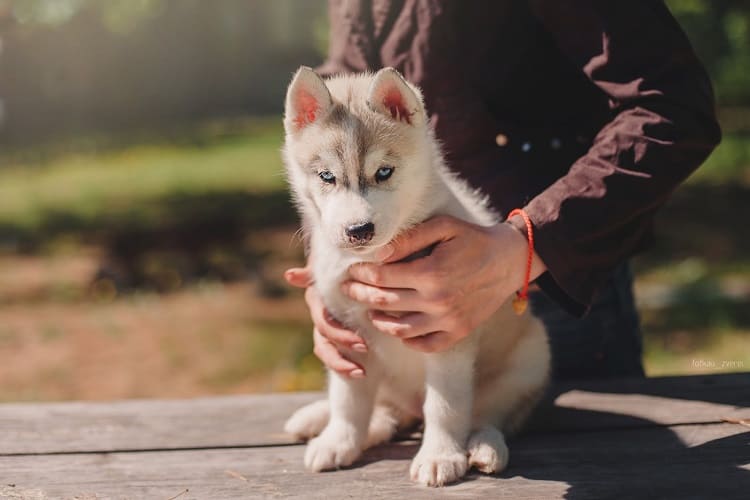Siberian huskies are a beautiful, graceful, friendly, and naturally clean canine breed and they are incredibly popular family pets across the world.
If you are planning to bring home a husky puppy, you must be prepared for an onslaught of fur—they are very heavy shedders. Don’t fret; it is not as messy and unmanageable as you are likely thinking. As a dog owner, you can easily manage your husky pup’s coat shedding throughout the year.
First, you need to know when do huskies shed their puppy coat so you can tackle the shedding head-on. We will also discuss caring for your husky’s coat as your puppy grows.
Let’s dive in!
Husky Double Coat Explained
Huskies have a double coat, which means their outer covering is made up of two layers: the topcoat and the undercoat.
These working dogs were first bred in cold climates that reached freezing temperatures, so they developed a double coat for protection against harsh weather conditions. Their fur is meant to keep them warm and cozy even as they trudge through feet of snow.
Today, Siberian huskies are born and bred all over the world, even in tropical countries. Owners must maintain these coats to ensure a happy and healthy husky.
Topcoat
A husky’s wiry topcoat consists of stiff, water-resistant guard hairs that wick away moisture. They guard the undercoat and skin from cold and moisture.
The topcoat does not develop until the husky reaches adulthood.
Undercoat
The undercoat is a soft, plush, and dense layer of fur beneath the topcoat. It is a secondary layer of fur that traps heat and keeps the body insulated. The undercoat makes it difficult to see a husky’s skin.
Huskies usually shed hair from the undercoat. Having an undercoat makes this breed much more prone to matting.
When Do Husky Puppies Start To Shed?
Knowing when do huskies shed their puppy coat will prepare you for the overload of fur you will soon encounter everywhere.
It will also help you understand how your husky puppy is growing so that you can make sure that it is healthy.
Husky puppies usually start to grow patches of fur in the first few weeks after they are born. You will see bits of fur coming up around your pup’s face and later on its legs. By the time its initial coat growth ends, it will look like a giant furball—perfect for cuddling!
This original puppy coat will begin to fall off once your husky pup is about ten months old. Don’t be alarmed if you see patches of missing hair on your pup and find bunches of fur all over your house and belongings.
At around 12 months old, your puppy will shed heavily and look scruffy and patchy. This marks the end of its fluffy puppy coat and the growth of its signature double coat. The original coat should be entirely shed by month 14.
Do Huskies Shed All Year Round?
Once your husky sheds its puppy coat and grows its new adult coat, it will continue to shed bits of fur throughout the year.
However, it will only blow out or completely shed its fur two times every year: once during the winter and another before spring or summer. These shedding periods usually last two to five weeks.
Most huskies shed their fur entirely at least once a year. During these annual blowouts, their shedding levels are exponentially higher than their puppy shedding. Be prepared to up your cleaning schedule when the time comes.
Keep in mind that the climate you live in and your husky pup’s genetics can significantly impact the amount of shedding that it goes through.
Should You Brush Your Husky Puppy?
Husky pups do not shed much outside of their standard shedding periods. You do not need to brush your pup’s coat too much to remove any loose hair, as there is not much there.
Nonetheless, introducing your pet to a brushing routine early on is essential. When your pup learns to enjoy the occasional brush down, you will not have trouble sitting it down to groom during the annual shedding seasons.
To help your pup get acquainted with a brush, allow it to inspect and sniff one—ideally a gentle pin and bristle brush or a slicker brush. Once it’s done sniffing the brush, bring its attention away from it with toys and treats. Repeat this process for about a week until your pup no longer cares about the brush.
You can then start gently brushing your pup’s fur. Always brush in the direction of the hair growth and not against it.
As you brush its coat, continue using treats and toys to distract it from the brushing. This will help your pup associate the brushing routine with rewards and playtime. This positive association is crucial to all your future grooming efforts, so you must ensure it goes well.
If your pup still does not like being brushed, set the brush aside and use treats and other positive reinforcement methods to calm it down. Once it is happy with its treats, try brushing it again.
Always be gentle and patient with your pup as you brush its fur. It needs to see brushing as a fun and rewarding process and not a punishment.
Once your pet grows used to brushing, you can limit the routine to once a week. During the shedding or blowout seasons, you will need to brush it at least once a day to ensure healthy growth and remove dead hair.
If you can, always brush your husky outdoors. This will limit the amount of stray hair you will encounter inside your house.
Husky Puppy Coat Care
Taking care of a husky’s coat may seem intimidating, but in truth, it is much easier than other dog breeds with double coats.
With careful planning and these helpful tips, you can prepare for the blowout season and help your pet stay clean and well-groomed.
1. Do Not Shave Your Husky Pup’s Coat
With the large amounts of fur that your husky pup sheds daily, you may be tempted to shave it all off. However, shaving or cutting off its fur will not put an end to the shedding.
A husky’s double coat is vital for your pup’s health as it regulates its body temperature. Cutting or shaving it will only make the undercoat—which grows rather quickly—outgrow the shaved topcoat and create a tangled, matted mess. If your husky pup’s topcoat is matted, it may become overheated during summers.
Shaving your pup’s coat may also result in bald patches, uneven growth of the double coat, and damage to the skin.
2. Bathe Your Husky Pup
A husky does not need frequent baths as its coat does not produce too much oil. In fact, if it is bathed too often, it will lose the natural oils in its fur, leading to dry skin and other health issues.
Bathe your husky pup once every three to four months—only when you see its coat starting to mat, knot, or become a bit smelly.
Bathing your pup can help you remove dead hair from its undercoat. Using mild and natural anti-shedding shampoos and conditioners can also limit shedding. Make sure that you rinse its coat thoroughly as the thick and dense hairs can easily trap product residue.
Brush down your pup’s coat while it is still damp. This is the most straightforward and pain-free way to remove clumps and keep the hair tidy and well-groomed.
3. Use A Wide-Toothed Comb
When you brush your husky pup’s coat, use a wide-toothed comb or an undercoat rake to remove matted hair. Comb the undercoat thoroughly to remove trapped dead fur.
4. Use Good-Quality Grooming Tools
Only use high-quality grooming tools that will not harm your husky’s coat.
The best equipment will make the grooming routine a breeze for you and your pup. They can also help you clean your husky’s coat much more quickly and effectively.
5. Feed Your Husky Pup A Healthy Diet
Sometimes the root cause of a husky’s excessive fur shedding is its diet. Feed your pup a nutritional and balanced diet to keep allergies, skin problems, and other health issues at bay.
Supplementing its diet with fish-derived Omega-3 oil can prevent excessive dryness in its coat, which can be another cause of unhealthy shedding.
Conclusion
We hope that our guide helped you understand when do huskies shed their puppy coat and what you can do to control their shedding.
If you enjoyed reading this, browse our website for more articles and blog posts that will help you keep your dog healthy.

Dan is a well respected content researcher who has vast experience working projects in the pets niche. He is a frequent contributor to dogtemperament.com and loves delivering numerous helpful dog articles like this one that are read by thousands of our readers monthly.





